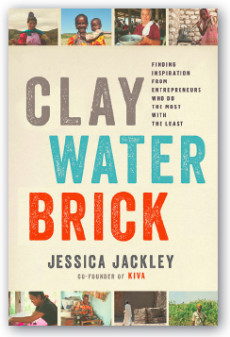I have learned to ask hard questions, and to go get answers for myself firsthand,” Jessica Jackley writes in Clay Water Brick. “I know now that it is always worth getting closer to the people I want to understand, so I can hear their truths from them directly. I know not to wait for permission to explore or learn or do the things I’m passionate about.”
If the measure of a successful book is its capacity to make you think harder about your place in the world, then Clay Water Brick counts as a success. It’s a case study in social entrepreneurship, and it’s of special interest because Jackley is a cofounder of Kiva, a much-respected online microfi nance platform. Along with Grameen Bank, Kiva popularized microfi nance in the United States as an eff ective tool for both poverty alleviation and women’s empowerment. By recounting the twists and turns of her story, Jackley presents us with the raw material that we need to ask our own “hard questions.”
Jackley grew up in an environment that she likens to “a modern Norman Rockwell painting”: “Everyone around me looked healthy and well fed,” she writes. At an early age, when most kids are finger-painting, Jackley precociously worried about her soul. “I felt anger, sadness, fear, guilt, even shame about my own relative wealth and privilege as a white, middle-class American kid,” she recalls.
When she was five and a half years old, a Sunday school teacher introduced her to the problem of poverty by quoting Jesus: “What you do for the least of these you do for me.” The prospect of becoming a “cosmic helper” who would aid the poor inspired Jackley as a girl, she recalls. But another saying of Jesus troubled her: “The poor will always be with us.” She recoiled from that idea. “Why would God make poor people stay poor forever? …” she asks. “And what did this mean for me? Were my plans to help the poor destined to be inadequate? Was Jesus setting me up to fail?”
The quest to prove Jesus’ fatalism wrong has occupied the rest of Jackley’s life, and it fills the balance of her book. In that quest, Jackley has drawn inspiration not only from role models like Nobel laureate Muhammad Yunus, founder of Grameen Bank, but also from Kiva’s borrowers—from clay-brick makers, seamstresses, vegetable sellers, and others who embody the entrepreneurial spirit. Entrepreneurialism, she asserts, is the most effective economic development strategy.
Why do some people—like Jackley—become not just entrepreneurs but social entrepreneurs? What is it that fosters empathy and a passion for social justice? This book isn’t about philosophy or ethics, so Jackley isn’t particularly reflective about those questions. Instead, she focuses on sharing her journey—her effort to lead a meaningful life and to seek her own way.
Jackley, for example, is clear-headed about following her own path. When Kiva was in its infancy, a “well-known tech company” that was engaged in a corporate social responsibility initiative proposed to finance $10 million in microloans using the Kiva platform. Jackley turned down the offer. “Taking that $10 million and simply dumping it into the system would have led us to drift from our core mission,” she writes. “In fact, the potential cost of taking that money would have been to turn away up to four hundred thousand individual lenders (if they each loaned $25).”
To explain this seemingly counter-intuitive decision, Jackley notes that Kiva’s animating vision has always focused on establishing “connections” between people. On one side of each of those connections are people with cash (lenders); on the other side are entrepreneurs in need of cash (borrowers). For Kiva, in short, Internet-based micro-lending is a means to an end—a tool of mass education in the service of global citizenship.
That was news to me. I had assumed that the mission of Kiva was simply, or primarily, about poverty alleviation. Jackley’s advice to her fellow social entrepreneurs about the need to stay on mission is wise. But I wonder how the lending public would have reacted if Kiva, in its formative years, had widely publicized its rejection of $10 million. I also wonder how an impoverished mother in the developing world who is struggling to start a business or to pay a medical bill would react to this information. Jackley, however, is silent on how she has balanced the countervailing forces that have buffeted her career.
Toward the end of Clay Water Brick, Jackley voices a sentiment that should resonate with every social entrepreneur: “Once in a while I still feel overwhelmed, and the great rift between the people I want to serve and myself seems vast, no matter what I do.” Jackley’s story, as told in this book, offers a response to that feeling of despair. It can be summed up in two words: resilience and resolve.


